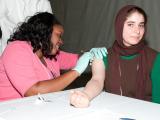Nov 13, 2009 (CIDRAP News) – Today's weekly influenza reports from the Centers for Disease Control and Prevention (CDC) contain some hints that the fall wave of H1N1 flu may have crested, though cases are still widespread over most of the country.
Visits to the CDC network of sentinel doctors for influenza-like illness (ILI) declined last week for the second week in a row, and the number of states with widespread flu activity dropped from 48 to 46, the agency reported.
On the other hand, the percentage of deaths attributed to pneumonia and flu both continued to climb, the CDC said. In addition, another 26 pediatric deaths linked to confirmed H1N1 cases were reported, bringing the total since April to 156.
ILI-related visits last week made up 6.7% of all visits to doctors, which is down from 7.7% the week before, the CDC said in its detailed weekly FluView report. Visits dropped in all regions except New England.
"This is the second week of national decreases in ILI after four consecutive weeks of sharp increases," the agency said in its general H1N1 Situation Update. "While ILI declined nationally, visits to doctors for influenza-like illness remain higher than what is seen during the peak of many regular flu seasons," the agency update said.
The CDC says that all states except Hawaii, Mississippi, Nebraska, and Texas had widespread cases last week; those states had regional activity. Only two states had less-than-widespread activity the previous week.
The proportion of deaths related to pneumonia and flu in the CDC's 122-city mortality reporting system reached 7.7% last week, which was above the epidemic threshold of 6.8% for the week. The percentage has been above the threshold for 6 weeks in a row, the agency said.
However, charts in the FluView report show that the numbers of hospitalizations and deaths related to influenza of all types both dropped last week compared with the week before. The charts indicate something in excess of 3,000 hospitalizations and between 100 and 150 deaths last week. The CDC says that more than 99% of viruses in circulation are the 2009 H1N1.
Thirty-five children's deaths related to flu were reported last week. Of those, 26 were linked to confirmed H1N1 infections, while 8 involved influenza A viruses that were not subtyped, and one involved type B, the CDC reported.
The number of pediatric deaths attributed to confirmed H1N1 cases since April has reached 156; another 23 cases involved confirmed flu viruses that were not subtyped.
The total of 156 is higher than the number for any seasonal flu epidemic of the past 5 years, according to numbers listed in today's Morbidity and Mortality Weekly Report (MMWR). The article says the highest pediatric death toll in that span was 153, with an average of 82.
The FluView report says deaths due to confirmed flu from Aug 30 to Nov 7 totaled 877, and there were 22,364 hospitalizations related to confirmed flu in that period.
Those numbers include only confirmed flu cases. Yesterday the CDC presented a new estimation method, in part to allow for untested cases. Using that method, officials estimated total US H1N1 deaths since April at 3,900.
The number of oseltamivir-resistant H1N1 isolates found in the United States through October is 14, out of 256 isolates tested, according to the MMWR article. Twelve of the 14 patients had received the antiviral drug for treatment or prevention.
See also:
CDC H1N1 Situation Update page
http://www.cdc.gov/h1n1flu/update.htm
CDC's weekly FluView report
http://www.cdc.gov/flu/weekly/
CDC. Update: Influenza activity—United States, August 30–October 31, 2009. MMWR 2009 Nov 13;58(44):1236-41 [Full text]


















